*Updated 3-Dec-2019* The option to prepare these biscuits with leaven has been included below.

Good day, good readers! How many of you managed to catch Alberto Angela’s two-hour documentary ‘Stanotte a Pompeii‘ tonight on RAI Uno or RAI Play? I was moved by the scene that was filmed inside of the domestic bread bakery in the Casa dei Casti Amanti (The House of the Chaste Lovers) at Pompeii (Italy). Alberto invited viewers into the house, which is presently closed to the public, and spoke briefly inside the bakery about its oven and the infamous panis quadratus bread that was manufactured in the many bakeries in the ancient town. Moreover, he gave us a glimpse into something that we rarely get to see in a Pompeian bakery setting and that’s an idea as to how many animals worked inside these bakeries. Towards the end of the scene in the bakery, Alberto took viewers into the stables which are adjacent to the main bakery and milling room. Inside the stable he showed us the skeletons of 5 mules that were excavated and remain in situ on the floor of the stable where they collapsed and met their tragic deaths 1,939 years ago during the eruption of Mount Vesuvius. These mules were responsible for milling grain and for transport and they were just as integral to bread production as the pistores were. Every time I see an image of these poor creatures it reminds me of how commonplace draft-animal labour was in Roman bakeries and how dependent the Romans were on these animals for their daily bread supply. If it weren’t for these hard-working animals, grain wouldn’t have made it into the bakeries from the hinterlands or the ports and it wouldn’t have been milled into the flour required to make the bread that fed the Roman people. The Romans owed their survival to these beasts of burden so I think it’s only fair that archaeologists and historians acknowledge them and their role in Roman daily life as well.
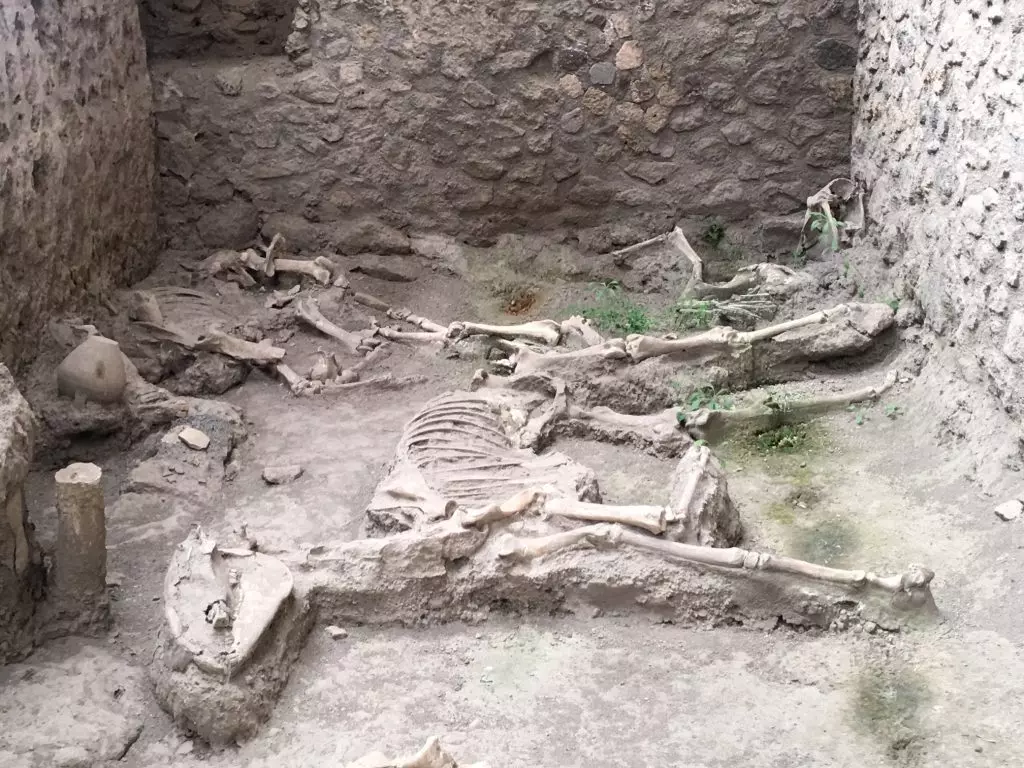
If we’d like a more accurate view into what life may have been like for draft-animals inside of Roman bakeries, we need only to refer to the ancient Roman written record. The Metamorphoses of Apuleius, or The Golden Ass (2nd c. AD), gives readers just that. In this section of the book, the narrator describes his perspective and experience as a bakery mule and gives us all a painful look at what a day in its life must have been like. Here’s a few telling passages below:
Metamorphoses of Apuleius (The Golden Ass), Books 10-13:
“Next day they took me out and put me up once more for sale by the auctioneer. A baker from the next hill-town bought me for seven sesterces more than Philebus had paid earlier. Immediately he loaded me to capacity with grain that he purchased as well, and took me, by way of a steep path dangerously full of sharp stones and all sorts of roots, to the mill which he operated.
 There the multiple circuits performed by numerous beasts kept turning millstones of varying circumference, and not merely by day but throughout the night they would sleeplessly produce flour with the non-stop rotation of the machines. But as for me, no doubt to keep me from being terrified by my introduction to slavery, my new master furnished me with a lavish reception: he gave me a holiday that first day and spread my manger generously with fodder. But that happy life of leisure and feasting did not last long, for the next day I was attached early in the morning to what appeared to be the largest of the mill-wheels. My head was covered and I was immediately given a push along the curved track of a circular channel. Within an orbit circumscribed all round, ever going back over my own path, I retraced my very footsteps and blindly wandered on an invariable course. I had not, however, completely forgotten my shrewdness and intelligence, and so I did not give the impression of being an easy learner in my apprenticeship to the profession. Although, when I was living in the world of humans, I had often seen mill-wheels being driven round in a similar way, I pretended to be inexperienced and ignorant of the process, and I stood rooted to the spot in feigned stupidity. I reckoned, you see, that I would be judged unfit and quite useless for this sort of service and delegated to some other sort of work, in some way easier, or perhaps even left to feed at leisure. But I exercised that pernicious cleverness of mine to no avail. Several men armed with sticks surrounded me at once. As I stood there, still unsuspecting because my eyes were covered, they suddenly gave a signal and shouted all together, laid into me with a heap of blows, and so upset me with the uproar that I immediately abandoned all my schemes, tugged skillfully at my rope-halter with all my might, and briskly performed my laps.
There the multiple circuits performed by numerous beasts kept turning millstones of varying circumference, and not merely by day but throughout the night they would sleeplessly produce flour with the non-stop rotation of the machines. But as for me, no doubt to keep me from being terrified by my introduction to slavery, my new master furnished me with a lavish reception: he gave me a holiday that first day and spread my manger generously with fodder. But that happy life of leisure and feasting did not last long, for the next day I was attached early in the morning to what appeared to be the largest of the mill-wheels. My head was covered and I was immediately given a push along the curved track of a circular channel. Within an orbit circumscribed all round, ever going back over my own path, I retraced my very footsteps and blindly wandered on an invariable course. I had not, however, completely forgotten my shrewdness and intelligence, and so I did not give the impression of being an easy learner in my apprenticeship to the profession. Although, when I was living in the world of humans, I had often seen mill-wheels being driven round in a similar way, I pretended to be inexperienced and ignorant of the process, and I stood rooted to the spot in feigned stupidity. I reckoned, you see, that I would be judged unfit and quite useless for this sort of service and delegated to some other sort of work, in some way easier, or perhaps even left to feed at leisure. But I exercised that pernicious cleverness of mine to no avail. Several men armed with sticks surrounded me at once. As I stood there, still unsuspecting because my eyes were covered, they suddenly gave a signal and shouted all together, laid into me with a heap of blows, and so upset me with the uproar that I immediately abandoned all my schemes, tugged skillfully at my rope-halter with all my might, and briskly performed my laps.
I excited the whole company to laughter by my sudden shift in philosophy.
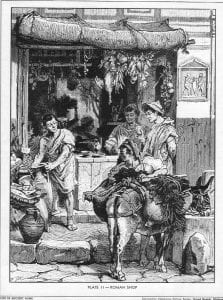 After most of the day was past and I was worn out, they took off my rope-collar, disconnected me from the machine, and fastened me to the manger. Although I was exceedingly exhausted, desperately in need of repairing my strength, and really dead from hunger, yet my habitual curiosity held me spellbound and made me quite anxious. So I postponed the plentiful dinner at hand and took a certain pleasure in carefully observing the routine of this undesirable workshop.
After most of the day was past and I was worn out, they took off my rope-collar, disconnected me from the machine, and fastened me to the manger. Although I was exceedingly exhausted, desperately in need of repairing my strength, and really dead from hunger, yet my habitual curiosity held me spellbound and made me quite anxious. So I postponed the plentiful dinner at hand and took a certain pleasure in carefully observing the routine of this undesirable workshop.
Good gods, what stunted little men they were! The whole surface of their skin was painted with livid welts. Their striped backs were merely shaded, not covered, by the tattered patchwork they wore: some had thrown on a tiny cloth that just covered their loins, but all were clad in such a way that you could discern them clearly through their rags. Their foreheads were branded, their heads half-shaved, and their feet chained. They were hideously sallow too, and their eyelids were eaten away by the smoky darkness of scorching murk until they were quite weak-sighted; like boxers who fight sprinkled with dust, they were dirtily whitewashed with a floury ash.
As for my comrades, the animals, what can I say? How can I describe their condition? What a sight! Those old mules and feeble geldings stood round the manger with their heads sunk down, munching through piles of chaff; their necks sagged from the rotting decay of sores; their flabby nostrils were distended from constant coughing; their chests were ulcerated from the continual rubbing of the rope harnesses; their flanks were bare to the bone from everlasting whipping, their hoofs stretched out to abnormal dimensions from their multiple circling, and their entire hide rough with decay and mangy starvation.”
(Source: The Digital Loeb Classical Library)
It’s rather saddening to read the above passages and to take in the image of the remains of the 5 mules in the Casa dei Casti Amanti while considering the fact that these animals were the power behind the food-processing technology in Roman bakeries. The catilli did not turn themselves! There was no electrical grid to draw off of in ancient Rome and if a water-mill was not an option then a mule, or a horse, was the most efficient way for a pistore to mill his grain into bread flour. So, in honour of these beautiful beasts of burden, these four-legged pistores, I am turning my attention once more to Roman bread and will be presenting a rather unusual and delicious recipe for this article that incorporates milled flour, grape must and cheese: Cato’s Grape Must Cakes. But first, let’s have a brief look at the grape in the Roman diet.
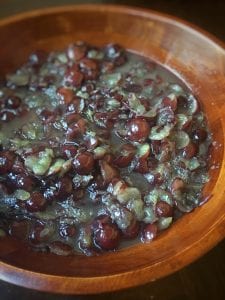
If there’s one thing that we’ve learned about Romans in the kitchen thus far, it’s that they did not waste food; they used and consumed everything that was edible from offal and stale bread to wheat bran and fish guts. If food could be made from it, the Romans would find a way. Like figs, grapes provided Romans with an enjoyable fruit that was consumed fresh or preserved by drying for consumption over the winter months. Another thing we know about the Romans is that they also used grapes to make wine. They were prolific winemakers and even had a use for the grape pulp and skins, known as grape must in the historical written record, so as to not waste this by-product of the wine-making process. One of the uses for grape must in the Roman kitchen was in the preparation of a grape must reduction syrup, known as defrutum, which was used in the preservation of fruit and wine but was also used as a sauce and colourant for various meat dishes. Another wonderful use for grape must was to bake it into breads. Panis Mustaceus, for example, or in this case small unleavened sweet and savoury wheat cakes made of grape must, spices and cheese called ‘mustacei‘ or grape must cakes. So if you’re ready to get your bake on, let’s roll up our sleeves and get the catilli turning! But let’s give the mule the day off, shall we? Here’s what you’re going to need:
Baking Bread with the Romans: Part IV – Cato’s Grape Must Cakes (Mustacei)
Preparation
- 1 kg table or wine grapes
- 4.5 cups (550 gr) of whole wheat flour
- 1/3 cup (76 gr) of lard or butter
- 1/8 cup (38 gr) of stained ricotta or strained cottage cheese
- 1 cup (235 gr) of leaven/bread starter (optional)*
- 1 tsp cumin
- 1 tsp anise seed
- Bay leaves
*Note: The option to make these biscuits with leaven (yeast) has been added in the ingredients above. Since the initial publishing of this recipe, I found other contemporaneous Roman written sources (Varro, On the Latin Language, 2nd c. BC) that indicated that Globi (another unleavened recipe recorded by Cato) can indeed contain yeast! Therefore, I feel that adding yeast to this recipe also gives it a little extra something that makes them a real show-stopper.
Cato the Elder tells us how to make grape must cakes in the following manner:
Cato, De Agricultura, Book CXXI:
“Mustaceos sic facito. Farinae siligineae modium unum musto conspargito. Anesum, cuminum, adipis P. II, casei libram, et de virga lauri deradito, eodem addito, et ubi definxeris, lauri folia subtus addito, cum coques.“
From this passage we can understand the following in English:
“Recipe for must cake: Moisten 1 modius of wheat flour with must; add anise, cumin, 2 pounds of lard, 1 pound of cheese, and the bark of a laurel twig. When you have made them into cakes, put bay leaves under them, and bake.“
(Source: The Digital Loeb Classical Library)
What’s exceptional about this recipe from De Agricultura is that we actually have most of the volumes and measurements that we need to make this recipe accurately. What a gift! Hail Cato! We can literally convert and follow his recipe taking a bit of liberty only when it comes to the amount of must, anise and cumin. Here is how I converted and made Cato’s Grape Must Cakes using his measurements and ingredients:
1. 1 Roman modius is equivalent to approximately 8.7 litres. For this recipe I reduced the amounts to a manageable batch that would produce about 15 small cakes or biscuits about the size of an English Muffin. Everything in Cato’s recipe is being converted from Roman measures to modern weights and volumes and divided by 8.7 in order to reduce the amounts to a smaller batch based on one litre of flour. Here’s the conversion:
| Cato’s Roman weights/volumes | Equivalent | Divided by 8.7 | Conversion |
| 1 modius of flour | 8.7 litres | 1 litre | 550 gr or 4.5 cups |
| 2 lbs of lard | 660 gr | 76 gr | 76 gr or 1/3 cup |
| 1 lb of cheese | 330 gr | 38 gr | 38 gr or 1/8 cup |
| Anise | 1 tsp | ||
| Cumin | 1 tsp | ||
| Grape must | 450 gr or 2 cups |
2. Take 1 kg of grapes, wash them and crush them thoroughly in a large mixing bowl. Strain the juice from the pulp and must using a colander or cheese-cloth but keep the juice! You may need some if the mixture is dry due to the texture of the flour that you choose to work with.
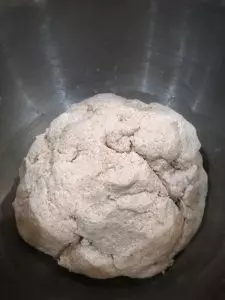 3. Prepare a large mixing bowl and add in all of the dry ingredients. If you’re milling your own flour, your mix may be coarser and drier. If you’re using pre-milled flour, prepare for a finer, wetter mix. Quickly mix the spices into the flour and create a well in the middle of the flour. Add 450 gr or 2 cups of strained grape must and pulp into the well and begin to fold it together. Knead it until the must is absorbed into the flour.
3. Prepare a large mixing bowl and add in all of the dry ingredients. If you’re milling your own flour, your mix may be coarser and drier. If you’re using pre-milled flour, prepare for a finer, wetter mix. Quickly mix the spices into the flour and create a well in the middle of the flour. Add 450 gr or 2 cups of strained grape must and pulp into the well and begin to fold it together. Knead it until the must is absorbed into the flour.
4. Add the lard/butter and cheese into the dough and knead it into the dough. This should add more moisture to the mixture. If you choose to use the leaven/starter in your dough, add it in now. If the dough begins to form a nice, workable wad of dough, take it out and begin kneading it on a counter surface or cutting board. If the dough is too dry or crumbly, add in a some of the remaining grape juice until the dough becomes workable and binds together firmly. Knead for 15 minutes.
5. Cover the dough with a damp cloth and let it stand for 30 minutes. This will allow the dough to strengthen and the gluten to bind.
6. Preheat your oven to 350 F / 180 C / Gas Mark 4
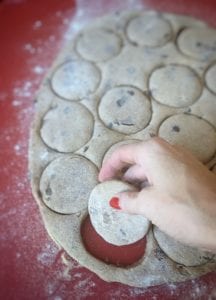 7. Dust a clean work surface or cutting board with some bread flour or semolina. Roll the dough out until it is approximately 1 cm or 1/2 an inch thick in height.
7. Dust a clean work surface or cutting board with some bread flour or semolina. Roll the dough out until it is approximately 1 cm or 1/2 an inch thick in height.
8. Using a cookie cutter or a glass or cup, cut round biscuits from the dough. I used a 7 cm diameter cookie cutter and was able to get 15 cakes from this amount of dough.
9. Place fresh or dried bay leaves onto your baking tray/dish and place each biscuit on top of one or two bay leaves to prepare them for baking. The biscuits will be baked on top of the bay leaves.
10. Bake your must cakes low and slow…. I’ve learned that this is key with unleavened breads that contain cheese or other fats. Libum, for example. I baked these grape must cakes for 20 minutes on 350 F / 180 C / Gas Mark 4 an they cooked beautifully. Golden on top, crispy on the edges, and baked thoroughly all the way through.
11. When the cakes are done baking, remove them from the oven and let them cool. Serve and eat when warm or room temperature… and try them with many different accompaniments! Nota bene: Remove the bay leaves after baking and throw them away. Do not eat them with the biscuit.

The final product for this test bake was quite pleasant indeed! Bearing in mind that the cakes are unleavened, they do not produce a texture that is like a fluffy, airy buttermilk biscuit, so don’t get your hopes up. But the flavours of these cakes are truly out of this world! Cumin and anise with the sweetness of grape must and a hint of bay?? Yes please, Cato! What a wonderful outcome that was. My feeling is that these biscuits, like tracta and other Roman flatbreads, were likely used to complement, scoop up or sop up stews and soups. I think they’d go beautifully with moretum as well. These sweet and savoury biscuits probably added a dose of flavour to blander accompaniments. I would also liken these biscuits to something akin to a Roman energy bar. They’re chewy and satisfying like an energy bar and when you consider the amount of carbs, fat and fibre in these biscuits they would have most likely filled your average Lucius up and kept his energy going throughout the day as well! I have half a mind to start making them regularly and consuming them with my morning coffee! Better yet, with a nice aged cheese… Lastly, I also have half a mind to add some bread starter into the mix next time as I believe that these must cakes would win fetch a pretty sesterce at the market if they were leavened. I think Cato would approve, don’t you?
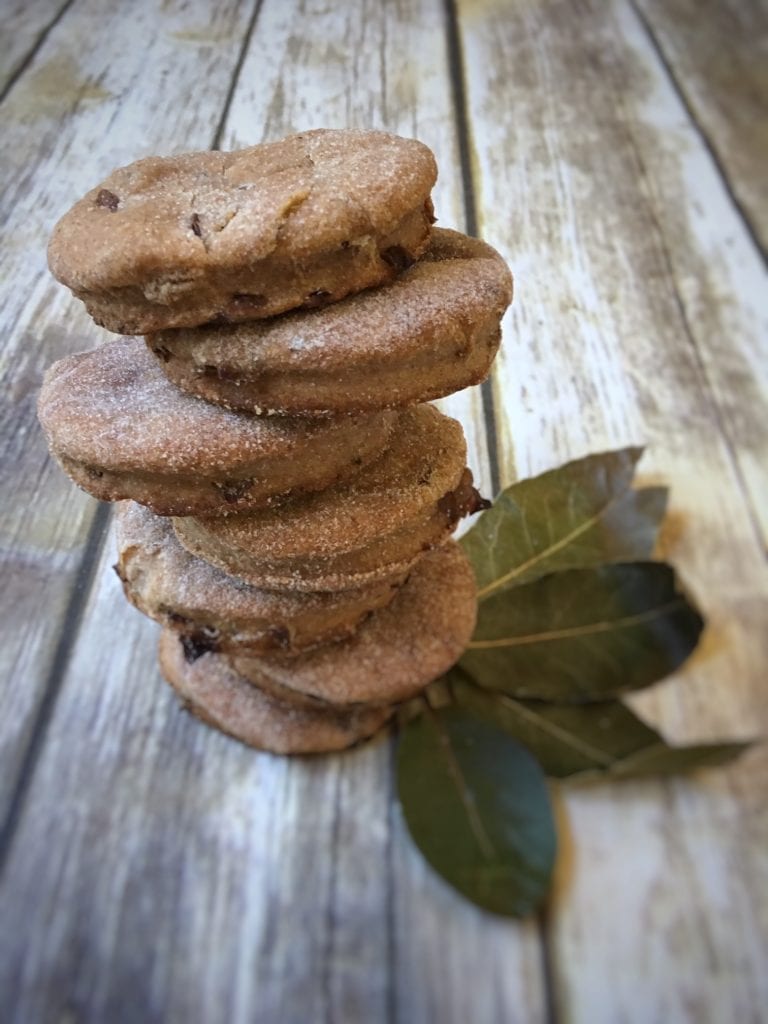
Feel free to leave comments or suggestions about this article using the comment form below. Did you try this recipe? If so, feel free to join the discussion and post photos on Tavola’s Facebook page.
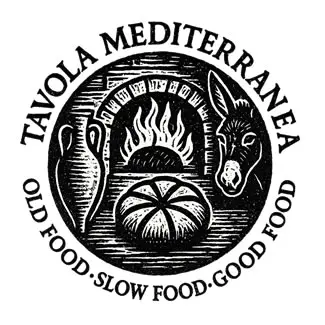
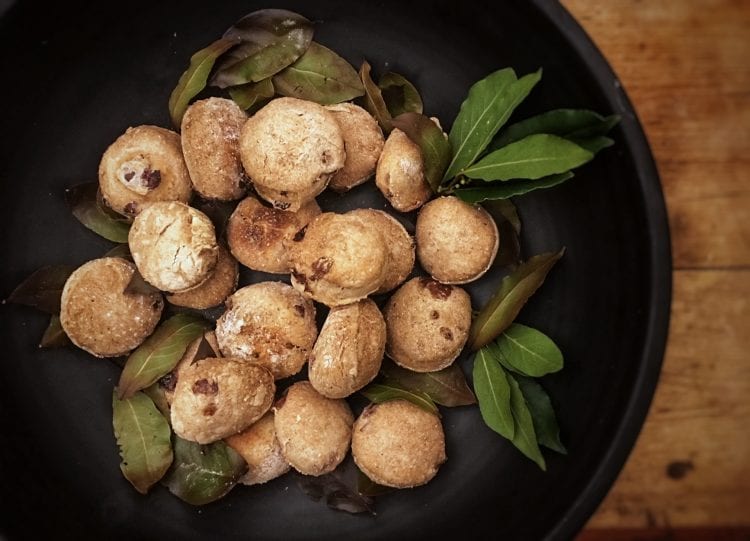




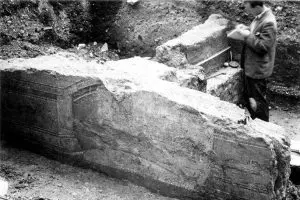


I just made these to go with duck in hazelnut crust. They’re excellent.
These are very good!
Thank you Frederic!